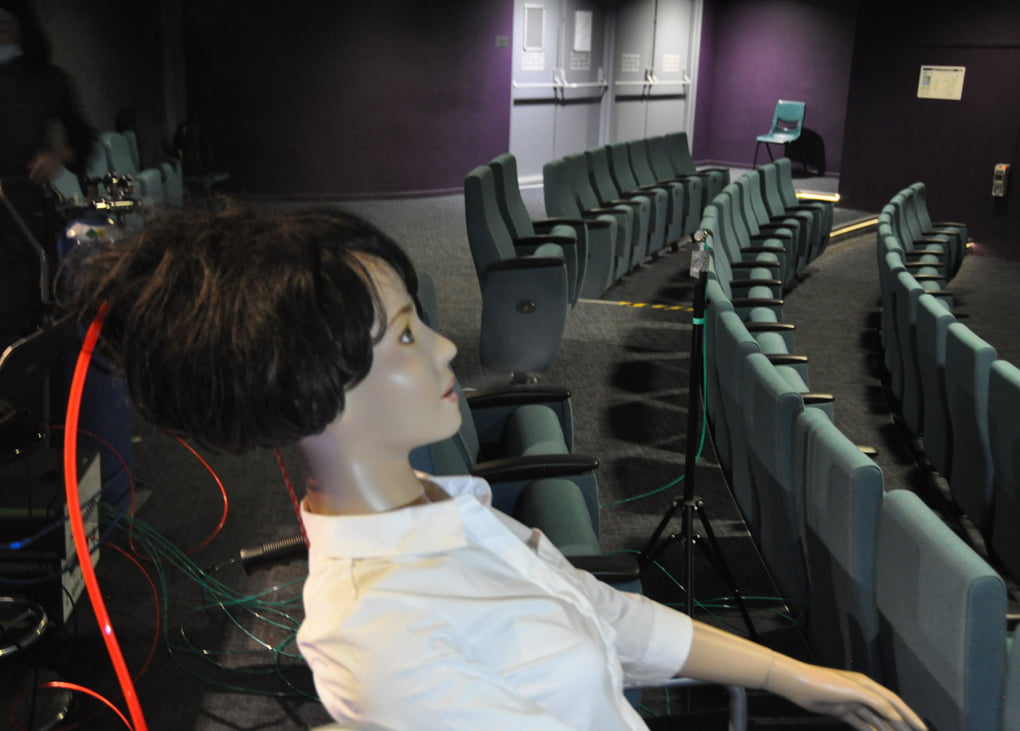In an Australian first, aerosol tests have been conducted to evaluate the impact of ventilation using a breathing thermal manikin. The results confirm the importance of fresh air in dispersing aerosols, highlight the role that airflows play in aerosol transmission, and raise questions about the effectiveness of a 1.5m social distancing rule indoors.
The team – which consisted of Ashak Nathwani AM, director, ARBS Education & Research Foundation; Professor Richard de Dear AM, University of Sydney; and Dr Jing Xiong, University of Sydney – used a breathing thermal manikin, named “Laura”.
“The idea of a breathing thermal manikin is to simulate the effects of the human body and the respiratory system on the emission of aerosols, that we now know to be the main transport mechanism or pathway for infection in COVID-19,” says Prof. de Dear.
“Laura has skin temperature and body form similar to a real person’s. The purpose of that warm skin surface is to drive a convective plume above the body. That convective plume interacts with the breath that we emit, and maybe carries some of the aerosols into the broader space.”
The tests were conducted at the Australian National Maritime Museum in Sydney’s Darling Harbour, in the theatre, cafeteria, and entry foyer. Photo-acoustic gas sensors were set up to detect the tracer gas, nitrous oxide. This was used to mark the manikin’s exhaled breath, simulating microscopic SARS-CoV-2 aerosols. N2O concentrations detected in the indoor air can be interpreted as a proxy for viral aerosol load. “Theatrical smoke” was also used to visualise the dispersion patterns in the exhaled breath of the infectious subject (manikin).
Readings were taken for three different scenarios: with HVAC systems turned off; with HVAC systems turned on and set to recirculate (with only 15 per cent fresh air); and with 100 per cent outdoor air using an economiser cycle. MERV13 filters were used in the HVAC system.
In the theatre, sensors were located next to the manikin and in the four rows of seats below. The highest concentration values of the tracer gas were detected when the air conditioning was on and set to 15 per cent outdoor air – even higher than for not having the air conditioning on at all. The researchers say this was primarily because the “contaminated” air was forced down when the air conditioning was started, from above head height to detector level.
In the cafeteria, at all sensor locations, concentration values increased uniformly with no ventilation but – as expected – decreased significantly when the door to the outside was opened. Surprisingly, however, concentrations decreased further when the door was left open and the air conditioning was turned off, presumably because there were no additional airflows from the air conditioning system to transport any reirculated aerosols.
Finally, in the entry foyer, the high ceiling was a major factor in lowering concentrations.
“It became evident that the tracer gas (viral aerosols) exhaled by the heated manikin was already buoyant and readily entrained in the plume rising above head height into the large ceiling void,” says Nathwani. “It needs to be pointed out that the foyer air conditioning was not operational and hence there was no interference in any way to the ‘convective plume’ from Laura.”
Tests were also done with different types of face masks. When a disposable surgical mask was placed over the manikin’s mouth and nose, there was obvious leakage around the edges, especially when the mask was worn loosely, as is usually the case in reality. When the team then correctly fitted an N95 mask over the manikin’s lower face, the leakage was noticeably reduced.
The team have identified a number of key findings from the research:
- The “virus”, in microscopic aerosol form, stays aloft in indoor air for a considerable period of time, depending on the quantity of ventilation air introduced, either through natural ventilation or via the air conditioning system.
- For an indoor dining setting, application of maximum fresh air ventilation resulted in the lowest “virus” concentrations throughout the occupied zone, confirming the widespread advice that outdoor dining affords the safest conditions.
- The “virus” concentrations did not vary significantly over distances ranging up to 6m from the index patient within indoor environments. Therefore, although the indoor 1.5m social distancing rule was conceived to minimise infection risks posed by respiratory droplets produced through coughing and sneezing, it seems ineffective in limiting the transmission of airborne infectious aerosols from an index patient who is simply breathing or talking.
- Indoor venues with large air volumes and high ceilings, such as entry foyers, places of worship, shopping malls and social halls, potentially have lower “virus” concentrations, provided there is no interference with indoor airflows from mechanical ventilation systems or fans.
- An ill-fitting disposable surgical mask showed noticeable leakage around the nose, while a properly fitted N95 surgical mask showed the least amount of leakage.
The research was funded by the ARBS Education & Research Foundation.
 Mark Vender
Mark Vender


Leave a Reply to Graeme Doreian Cancel reply